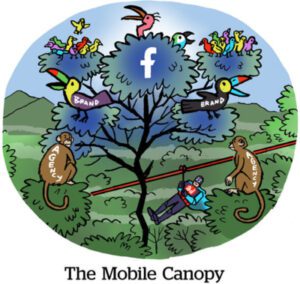BuzzFeed’s revenue is in free fall, and the company is counting on the robots to save it.
Q2 revenue was down 27% YOY to $77.9 million from $106.8 million.
In fact, all three of BuzzFeed’s main revenue streams declined year over year. Ad revenue was down 33% to $35.4 million, content revenue dropped 22% to $31.5 million and commerce and “other” revenue dipped 17% to $11 million.
And the outlook isn’t great going forward, CEO Jonah Peretti told investors on Tuesday.
“As Facebook and other major tech platforms continue to prioritize vertical video, traffic referrals from these platforms to our content have diminished,” Peretti said. “These dynamics have impacted monetization in Q2 and into Q3.”
To reverse the trend, Peretti said BuzzFeed is “laser focused” on using AI-generated content to drive audiences to its owned-and-operated platforms and away from social media.
Diminishing audience share
The shift away from social is a major departure for BuzzFeed, which built its brand largely on the strength of its social media presence. But its ubiquity in social feeds has been under threat dating back to Facebook’s major algorithm change in 2018, which reoriented the platform around promoting divisive political content rather than BuzzFeed listicles.
More recently, social media’s pivot to video (vertical this time) means audiences are spending less time engaging with BuzzFeed’s written content. Monetization opportunities on social media have dwindled to almost nothing, the company said in its earnings release.
Case in point: BuzzFeed has stopped including Facebook, Instagram, TikTok, Snapchat and Twitter – platforms “for which we have minimal advertising capabilities” – in its calculations for audience time spent engaging with content.
BuzzFeed still calculates time spent on YouTube and Apple News, but its share of audience attention on these platforms was down 9% YOY for Q2, dropping from 105 million to 96 million hours.
The split from Facebook is especially noteworthy. Facebook is where BuzzFeed cultivated its reach with millennials, mainly by sharing viral content on the platform. BuzzFeed frequently touts its young audience as a key differentiator. (It now cites its reach with both Gen Z and millennials, since millennials aren’t that young anymore.) But young people have largely abandoned Facebook, and BuzzFeed now says it collects an “immaterial amount of advertising revenue” from the platform.
BuzzFeed included time spent numbers as reported by Facebook in its earnings release, and they’re grim. In Q2 2022, Facebook users spent 48 million hours engaging with BuzzFeed content. That dropped to 15 million hours in Q2 2023.
The relationship with TikTok is more encouraging, according to BuzzFeed President Marcela Martin.
She pointed to BuzzFeed’s involvement in TikTok’s publisher partner program, noting it’s “the first time that publishers will be able to earn passive revenue from organically published content on the platform.”
BuzzFeed surpassed 1 billion views on TikTok for the first time this quarter. The company didn’t reveal how much revenue it generated from these views.
Bots upon bots
But what’s BuzzFeed’s plan for driving audiences to its own properties?
Peretti said BuzzFeed will publish more breaking news content, which is a rather baffling strategy considering the company shut down its BuzzFeed News division last quarter. Now its HuffPost brand will have to shoulder most of the responsibility for breaking news.
Doubling and tripling down on AI-generated content is the main strategy, though, and the experiment has been working, Peretti said. Readers are engaging with AI-enriched quizzes on BuzzFeed’s sites for two to four times longer than its non-AI quizzes.
So BuzzFeed is rolling out more AI-powered experiences across its portfolio.
Its cooking publication, Tasty, recently added an AI cooking assistant named “Botatouille” to its app, which offers recipe suggestions, menu recommendations and the like. And in keeping with its tried-and-true approach of leaning into viral online trends, BuzzFeed has been using generative AI to capitalize on cultural moments.
Its Complex brand launched an AI-powered mixtape album art generator to celebrate the 50th anniversary of hip-hop. And in response to the viral success of the “Barbie” movie, the flagship BuzzFeed site used an AI image generator to imagine what Barbie’s Dream House would look like in all 50 US states.
BuzzFeed’s first-party data offering, Lighthouse, is also getting the AI treatment, Peretti said.
The company has started experimenting with new AI models for categorizing content across its portfolio into contextual ad offerings, which it believes will help it stand out in the post-third-party-cookie marketplace.

















